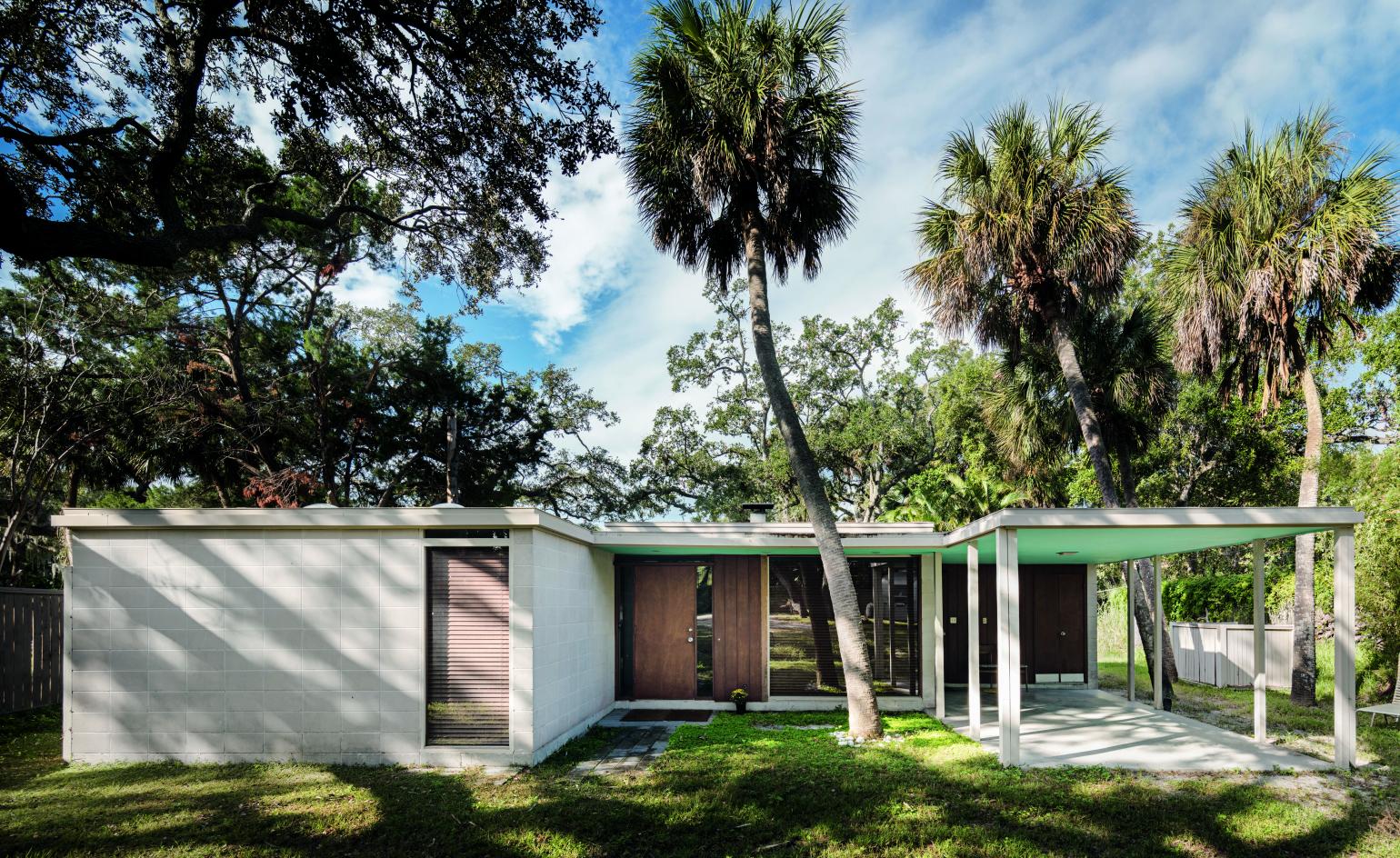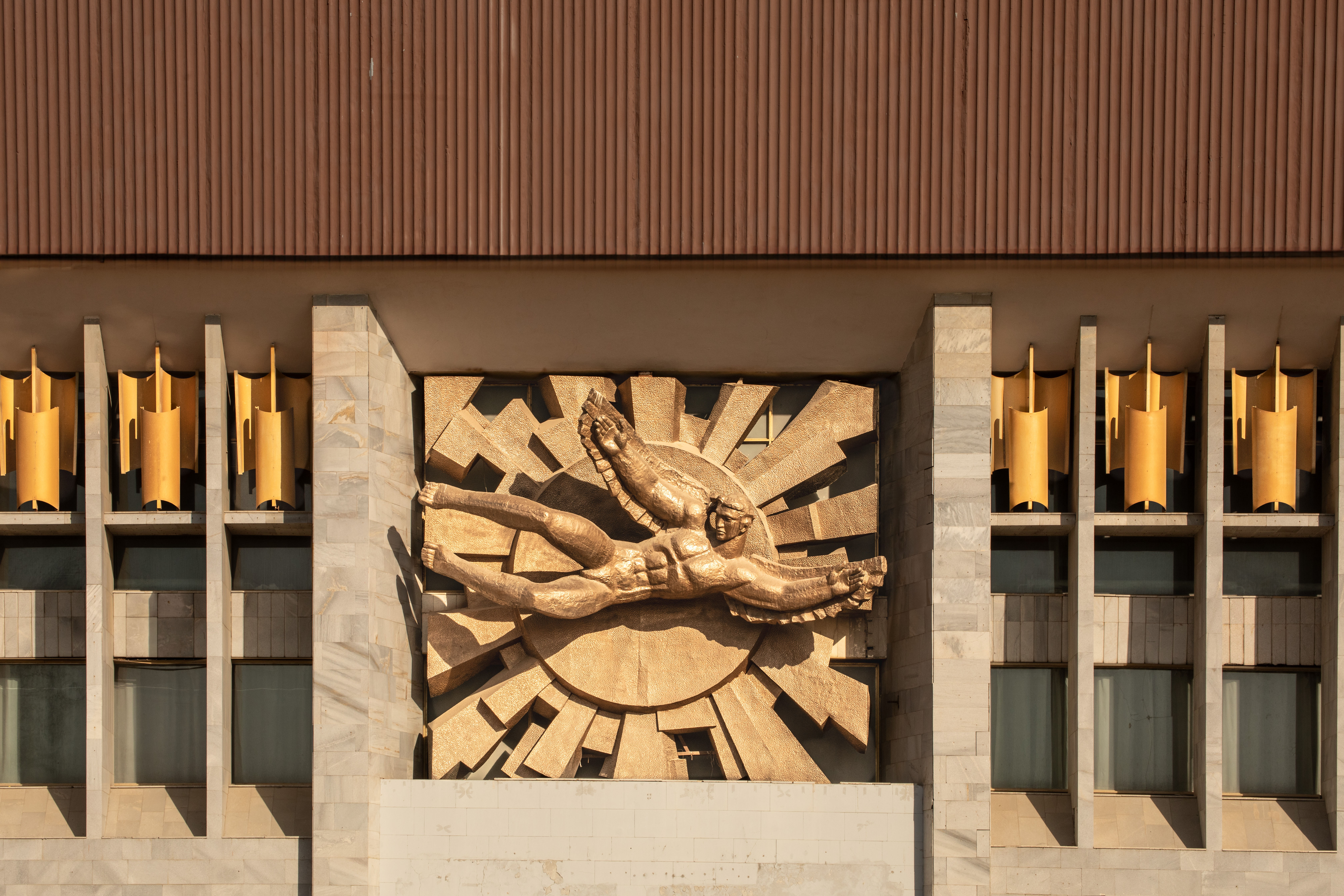Midcentury modernist enclaves on the East Coast uncovered in smart travel guide

For the residents of Palm Springs – and those who flock to the desert enclave for the annual Modernism Week – midcentury desert modernism is more than an architectural style, it’s a lifestyle choice. No other architectural sub-style has managed to capture such a distinct culture alongside it, yet author Sam Lubell and photographer Darren Bradley went on an East Coast search and found some strong contenders, notably, Sarasota.
Following a trail from Maine to Florida, Lubell and Bradley collated a neat travel guide of midcentury modern buildings down the East Coast. They sought out lesser known examples, each uniquely adapted to their geographical contexts and promoting an equally unique sub-style of modernism, from organic, to space-aged and classical.

Horgan Academy of Irish Dance, Alexander and Nichols, 1964, Naugatuck, Connecticut, US (page 68). Photography: Darren Bradley
During Palm Springs Modernism Week 2019, the pair will host an event exploring the various degrees of midcentury modernism, revisiting some of the 250 projects highlighted in the book where you can find directions and information for visiting, and admiring each midcentury masterpiece. We couldn’t wait to find out more...
Wallpaper*: What was your definition of ‘midcentury modernism’ when creating this book? Is it a time frame, a style or a feeling?
Sam Lubell: We took a wide definition of midcentury modernism, encompassing several modern styles and philosophies from the late 1930’s through the early 1970s. All modernist styles embraced the future, employed modern technologies, and clearly expressed their materials and functions. Many people conflate midcentury modern with the simple glass, concrete and steel forms of the international style, which grew out of an industrial vernacular and collective spirit and were later co-opted through so-called ‘corporate modernism’. But it played out in many more ways, following many muses, including natural-inspired organic modernism, space-aged googie, classically-modeled new formalism, concrete-loving brutalism, biologically-organised metabolism and much more.

Greater Refuge Temple, Costas Machlouzarides, 1968, New York, New York, US (page 119). Photography: Darren Bradley
W*: What was the most unexpected challenge you encountered on your travels down the coast?
Darren Bradley: Normally, as an architectural photographer, I do a lot of planning and have lots of time and unlimited access to a building that I'm photographing. But for a book like this, we were traveling from city to city down the coast. I was often photographing buildings that I was seeing for the first time, with little or no advanced notice, and in all weather and light conditions. Sometimes, I'd be harassed by security guards, or have to shoot around road construction in front of the building. Inevitably, large delivery vans seemed to always be parked right in front, etc. Murphy's Law happened more often than not. Regardless of the conditions, I had to figure out how to make it work, and get the shot. And I usually only had a few minutes in each location, and no chance to do it over again.
W*: Were there any buildings that didn’t make the cut that you want to shout out?
DB: There were several buildings that we couldn't include simply because they are not visible from the street or open to the public. The personal residence of IBM designer Eliot Noyes in New Canaan, Connecticut is one of them. Sam and I had the privilege of visiting the house on one of our trips, but we couldn't put it in the book. It is beautiful, and in perfect original condition.
W*: Did you discover the distinct breed of Palm Springs ‘desert modernism’ elsewhere in any other buildings? Or is it totally distinct and if so, why do you think this is?
DB: Good modernist architecture is usually pretty well adapted to its environment and climate. The modernist architecture of Palm Springs is designed for the desert, with flat or low-gabled rooflines that provide deep overhangs for lots of shade. They aren't worried about snow, ice, rain, or even mosquitos or other bugs. It never gets very cold, either. There aren't any deserts on the east coast, obviously, and so you don't find many Palm Springs-style houses. Surprisingly, we did find a few, though. There's one example in the book on Cape Cod, strangely enough. But it's a vacation home that's only used in the summer, I think. There are also some homes in Florida that are similar... I guess Florida is probably the closest – although more rain there, and more bugs.

Pier Sixty Six, Richard F. Humble, 1957, Fort Lauderdale, US. Photography: Darren Bradley
Wallpaper* Newsletter
Receive our daily digest of inspiration, escapism and design stories from around the world direct to your inbox.
W*: Palm Springs is synonymous with midcentury modernism. Is there an East Coast enclave with similar potential?
SL: There are several notable modernist enclaves along the East Coast, including New Canaan, CT, Litchfield, CT, Raleigh, NC, and of course major cities like New York, Boston, Miami and Washington. But the closest to Palm Springs in scale and climate is Sarasota, where a glut of talent, a future-loving spirit and progressive clients like Philip Hiss combined to create a must-see variety of modernist buildings.
Some of my favourites include Paul Rudolph’s Sarasota High School and Umbrella House, Victor Lundy’s St Paul’s Lutheran Church and Heron House, and the work of other noted modernists like Ralph Twitchell, Taliesen Associated Architects, Tim Seibert, Gene Leedy and more. Sarasota even hosts its own version of Modernism Week, SarasotaMOD Weekend, which takes place in the Fall.
W*: Can you describe your Palm Springs highlight to date?
SL: My Palm Springs highlight to date was our Modernism Week talk at the Ace Hotel two years ago for the West Coast Guide. Every seat was filled, and the audience was vocally passionate about modernism, and our exploration of it. The line for the book signing portion lasted about an hour. Those in line asked great questions and suggested useful projects for future guides. People who come to Modernism Week have an incredible understanding of what makes this time period, and these designs, so special, and it’s always a pleasure to interact with them. §
On the Road: Visiting East Coast Midcentury Modernism’ takes place at the Modernism Week CAMP Theater on 20 February 2019. See more news and highlights from Palm Springs Modernism Week here.

Unitarian Meeting House, Victor Lundy, 1962, Hartford, Connecticut, US (page 61).

Decatur High School, Bothwell and Nash, 1965, Decatur, Georgia, US (page 269).

W. W. Kerr Residence, Paul Rudolph, 1951, Melbourne Beach, Florida, US (page 292).

Lu Andrews House, Ralph Twitchell, 1969, Sarasota, Florida, US (page 293).

Umbrella House, Paul Rudolph, 1953, Sarasota, Florida, US (page 300).

Mortgage Corporation of America Building, Carson Bennett Wright, 1971, Miami, Florida, US (page 316).

The cover of the mid-century travel guide for East Coast US from Phaidon
INFORMATION
For more information, visit the Wallpaper* Modernism Week 2019 highlights, the Phaidon website and the Modernism Week website
Harriet Thorpe is a writer, journalist and editor covering architecture, design and culture, with particular interest in sustainability, 20th-century architecture and community. After studying History of Art at the School of Oriental and African Studies (SOAS) and Journalism at City University in London, she developed her interest in architecture working at Wallpaper* magazine and today contributes to Wallpaper*, The World of Interiors and Icon magazine, amongst other titles. She is author of The Sustainable City (2022, Hoxton Mini Press), a book about sustainable architecture in London, and the Modern Cambridge Map (2023, Blue Crow Media), a map of 20th-century architecture in Cambridge, the city where she grew up.
-
 All-In is the Paris-based label making full-force fashion for main character dressing
All-In is the Paris-based label making full-force fashion for main character dressingPart of our monthly Uprising series, Wallpaper* meets Benjamin Barron and Bror August Vestbø of All-In, the LVMH Prize-nominated label which bases its collections on a riotous cast of characters – real and imagined
By Orla Brennan
-
 Maserati joins forces with Giorgetti for a turbo-charged relationship
Maserati joins forces with Giorgetti for a turbo-charged relationshipAnnouncing their marriage during Milan Design Week, the brands unveiled a collection, a car and a long term commitment
By Hugo Macdonald
-
 Through an innovative new training program, Poltrona Frau aims to safeguard Italian craft
Through an innovative new training program, Poltrona Frau aims to safeguard Italian craftThe heritage furniture manufacturer is training a new generation of leather artisans
By Cristina Kiran Piotti
-
 Croismare school, Jean Prouvé’s largest demountable structure, could be yours
Croismare school, Jean Prouvé’s largest demountable structure, could be yoursJean Prouvé’s 1948 Croismare school, the largest demountable structure ever built by the self-taught architect, is up for sale
By Amy Serafin
-
 Jump on our tour of modernist architecture in Tashkent, Uzbekistan
Jump on our tour of modernist architecture in Tashkent, UzbekistanThe legacy of modernist architecture in Uzbekistan and its capital, Tashkent, is explored through research, a new publication, and the country's upcoming pavilion at the Venice Architecture Biennale 2025; here, we take a tour of its riches
By Will Jennings
-
 At the Institute of Indology, a humble new addition makes all the difference
At the Institute of Indology, a humble new addition makes all the differenceContinuing the late Balkrishna V Doshi’s legacy, Sangath studio design a new take on the toilet in Gujarat
By Ellie Stathaki
-
 How Le Corbusier defined modernism
How Le Corbusier defined modernismLe Corbusier was not only one of 20th-century architecture's leading figures but also a defining father of modernism, as well as a polarising figure; here, we explore the life and work of an architect who was influential far beyond his field and time
By Ellie Stathaki
-
 How to protect our modernist legacy
How to protect our modernist legacyWe explore the legacy of modernism as a series of midcentury gems thrive, keeping the vision alive and adapting to the future
By Ellie Stathaki
-
 A 1960s North London townhouse deftly makes the transition to the 21st Century
A 1960s North London townhouse deftly makes the transition to the 21st CenturyThanks to a sensitive redesign by Studio Hagen Hall, this midcentury gem in Hampstead is now a sustainable powerhouse.
By Ellie Stathaki
-
 The new MASP expansion in São Paulo goes tall
The new MASP expansion in São Paulo goes tallMuseu de Arte de São Paulo Assis Chateaubriand (MASP) expands with a project named after Pietro Maria Bardi (the institution's first director), designed by Metro Architects
By Daniel Scheffler
-
 Marta Pan and André Wogenscky's legacy is alive through their modernist home in France
Marta Pan and André Wogenscky's legacy is alive through their modernist home in FranceFondation Marta Pan – André Wogenscky: how a creative couple’s sculptural masterpiece in France keeps its authors’ legacy alive
By Adam Štěch